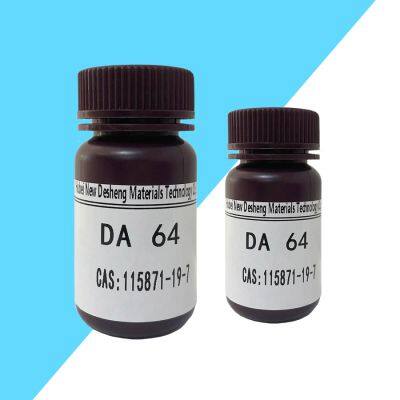Home > Products > Chromogenic substrate > Advantages and Characteristics of the Chromogenic Substrate DA64 (115871-19-7)
Advantages and Characteristics of the Chromogenic Substrate DA64 (115871-19-7)
- Shanghai
- T/T L/C
- 5 days
You May Like
-
Performance Characteristics and Usage Instructions of Color Developing Substrate DA67 115871-18-6
-
Analysis of Luminol 521-31-3 Chemiluminescence Characteristics
-
Introduction and Precautions of Luminol Monosodium Salt 20666-12-0
-
Isoluminol Reagent for Chemiluminescence
-
Luminescence Analysis of High-purity Acridine Ester NSP-DMAE-NHS194357-64-7
-
Direct Chemiluminescence of Acridine Ester DMAE-NHS 115853-74-2
Product Details
| CAS No. | 115871-19-7 |
Product Description
In the field of chemical analysis, the chromogenic substrate DA64 has become an important reagent in peroxidase (POD) detection systems. Its molecular formula is C19H23N4NaO3 and its molecular weight is approximately 378.39 grams per mole. It stands out for its superior performance and unique molecular structure, providing technical support for various analysis and detection applications. So, what are its advantages and characteristics? Let's explore together below.
Basic information of DA64
The appearance of the chromogenic substrate DA64 is white and exists in the form of crystalline powder. It has excellent solubility in water, with 40 milligrams of DA64 dissolved per 100 grams of water, and can dissolve in water at concentrations of over 1 millimole.
Advantages and Characteristics of DA64
There are many reasons why DA64 is popular in peroxidase detection systems, and its advantages and characteristics include the following three points:
1. Unique color development characteristics: DA64 has significant differences from traditional color substrates, with a color development wavelength λ max of up to 727nm. Most color substrates have a wavelength in the range of 400-550nm, while DA64 has a significantly higher color development wavelength. This feature makes DA64 exhibit stronger anti-interference ability in complex samples, and the absorption wavelength of many common interfering substances is different from the color rendering wavelength of DA64, making it easier to distinguish target signals.
2. High sensitivity: DA64 has a very sensitive response to POD catalytic oxidation. Its extinction coefficient (ε/H2O2) at a unit concentration of hydrogen peroxide (H2O2) is 9 × 104, which means that DA64 can generate color products with specific absorption wavelengths in the POD reaction. Even at very low target analytical concentrations, stable and reliable results can be obtained.
3. Widely used: DA64 is not only widely used in laboratory research, but also plays an important role in industrial and medical reagent kits, and can be used for various biochemical analyses, including enzyme activity determination, redox reaction, and immunoassay.
The colorimetric substrate DA64 stands out for its unique colorimetric properties, high sensitivity, and anti-interference ability, providing assistance for various research and determination. As an advantageous producer of chromogenic substrates, Desheng's DA64 is mainly used for measuring the content of glycosylated serum proteins in serum by chromogenic enzyme method, timely monitoring the patient's blood glucose level, and making prevention and diagnosis accordingly. Based on its high water solubility and sensitive reaction characteristics, it is highly popular in the market. If you also have relevant needs, please feel free to contact us for purchase at any time!
Contact Us

- Hubei New Desheng Material Technology Co., Ltd
- Contact nameDoris Yang Chat Now
Product Categories
| Additive for blood collection | Biological buffer | Chemiluminescence reagent | Chromogenic substrate |
| enzyme preparation |
New Products
-
Detailed Introduction of Luminescent Reagent NSP-SA 211106-69-3
-
Stability and Precautions of Acridine Ester (NSP-SA-NHS)
-
The Labeling Principle and Application of Acridine Hydrazide NSP-SA-ADH
-
Application and pH Stability of Acetyl CoA Oxidase
-
Tris and Glutamate Dehydrogenase Work Together on Homocysteine Assay Kit
-
The Relationship Between Purine Nucleoside Phosphorylase and Nucleic Acid Synthesis and Decomposition
-
Introduction of Desheng on Alpha Glucosidase
-
Glucose Dehydrogenase: a Key Enzyme in IVD in Vitro Diagnostic Reagents
-
Detailed Explanation of Storage Methods for Adenosine Deaminase (ADA)
-
Biological Functions and Applications of Malate Dehydrogenase
-
The Price of TRIS-HCL 1185-53-1 Produced by Desheng Has Been Lowered. Please Feel Free to Consult and Purchase
-
Why Should we Pay Attention to Solubility When Purchasing Biological Buffer TRIS 77-86-1?
-
The Effect of Purity of BICINE Powder 150-25-4 as a Biological Buffer on the Performance of Buffer Solutions
-
Introduction to the Transportation Packaging of CAPS Powder 1135-40-6, a Biological Buffering Agent
-
Compatibility of Biological Buffer MOPS 1132-61-2 With Other Reagents
-
Application of Biological Buffer TAPS 29915-38-6 in Enzyme Activity Research
-
The Advantage of High Purity of EPPS Powder 16052-06-5 Raw Materials for Biological Buffering Agents
-
Advantages of MOPSO Buffer 68399-77-9 in Low-temperature Biochemical Work
-
What Does HEPES Buffer 7365-45-9 do for Cell Culture
-
Application of Biological Buffer PIPES 5625-37-6 in Biochemical Research
-
How to Determine and Choose a BES Buffer 10191-18-1 Manufacturer for Procurement
-
Biological Buffer DIPSO (68399-80-4) Detailed Description for Quick Understanding
-
Multiple Applications of CHES Buffer in Biological Research
-
Advantages of High TOOS Molar Absorbance
Popular Searches
- sodium hypochlorite
- naclo
- hypochlorite
- calcium hypochlorite
- calcium salt
- potassium butyl xanthate
- calcium sodium
- sodium hypochlorite production
- sodium process
- granule sodium
- sodium hypochlorite water
- sodium 80% powder
- lime plastering
- sodium hypochlorite disinfection
- hypochlorite sodium
- sodium granular powder
- hypochlorite production
- electrolysis sodium hypochlorite
- swimming pool salt
- sea fish aquarium
- of calcium powder
- quotation sample
- aquarium coral
- emamectin benzoate wdg
- calcium price powder
- ptf
- aqua clear
- aquarium for sea water
- aquarium jellyfish
- aquarium white coral
Recommended Products
- Sodium Metasilicate Granular 25kg Powder
- Chlorine Dioxide Quick Test Kit
- Residual Chlorine Quick Test Kit
- Rapid Determination of Available Chlorine
- Quaternary Ammonium Sanitizer Concentration Test Strips [0~4000 Ppm]
- Quaternary Ammonium Sanitizer Concentration Test Strips [0~1000 Ppm]
- You Need to Pay Attention to These Three Erroneous Views When Purchasing Carbopol Powder
- Exploration of the Advantages of MAOS Chromogenic Substrates in Biochemical Detection
- Application of MADB 209518-16-1 in Serum Muscle Enzyme Detection Kit
- Basic Information of the New Trinder's Reagent HDAOS Powder Reagent
- What Items Can DAOS, a Chromogenic Substrate, be Used to Detect?
- Packaging Requirements for Exporting Color Developing Substrate ALPS Powder in Small Batches
Find Similar Products By Category
- Chemicals > Chemical Reagent
Product Tags:
- Please Enter your Email Address
- Please enter the content for your inquiry.
We will find the most reliable suppliers for you according to your description.
Send Now-
 Doris Yang
Hi there! Welcome to my shop. Let me know if you have any questions.
Doris Yang
Hi there! Welcome to my shop. Let me know if you have any questions.
Your message has exceeded the limit.

- Contact supplier for lowest price
- Customized Request
- Request Sample
- Request Free Catalogs
Your message has exceeded the limit.
-
Purchase Quantity
-
*Sourcing Details
Your inquiry content must be between 10 to 5000 characters.
-
*Email
Please enter Your valid email address.
-
Mobile



